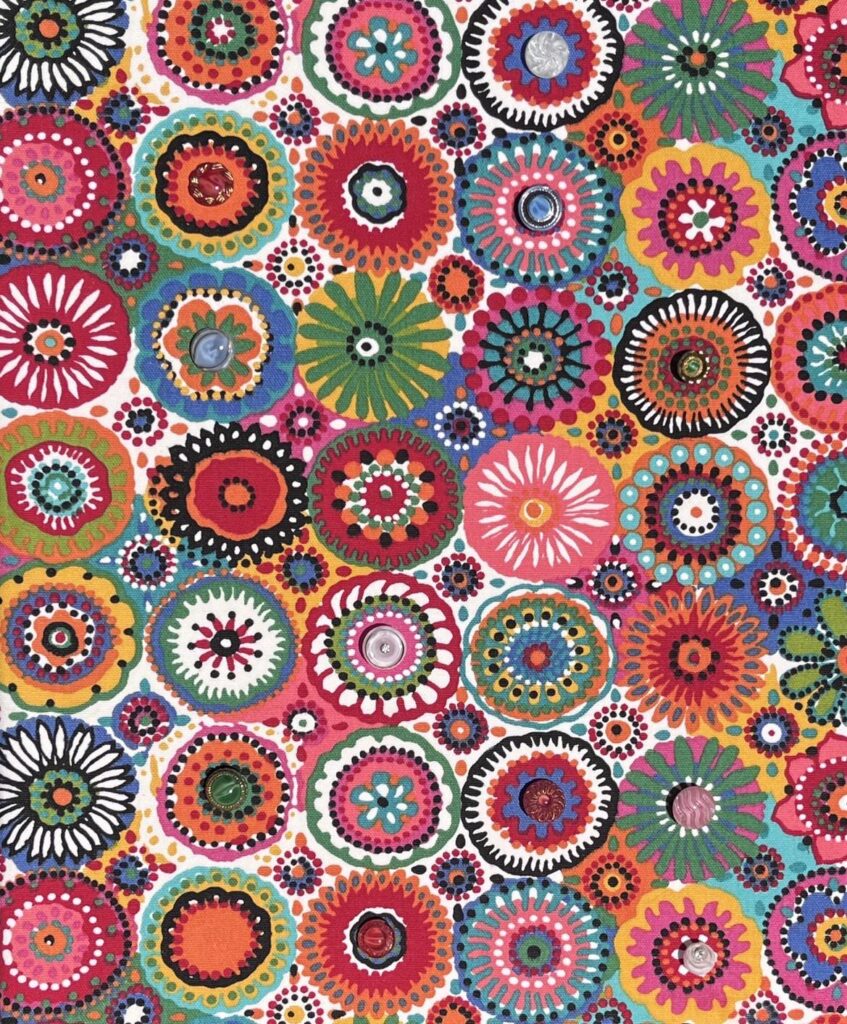A Jar of Buttons
Have you ever wondered why sorting through a jar or cookie tin of buttons is magical? Whether it’s from your grandma or an estate sale, there is thrill in the hunt. But I think it’s more than that. Perhaps part of the fascination relates to the story behind each button. While some buttons are still on their original sales card or look like the extras from a dress shirt or suit coat, others are so unique they look custom-made. Some buttons are clearly used but have endured the test of time. Others, not so much.
Every Button Tells a Story
Looking closely at a button, it will begin to tell you its story.
At a glance, two buttons may look similar. However, if you want the true story, you may want to use a magnifying glass, a bright flashlight, and maybe even an ultraviolet light. These tools help identify the material used to make the button. For example, glass buttons really sparkle and have a clarity you can’t find in plastic ones. A glass button is also heavier than plastic and makes a sharp clicking sound if you tap it on your teeth. For more information, check out this article on Identifying Glass Buttons from The Peacock Box.
Pearly iridescent buttons are often made from shells. To confirm whether it’s plastic or shell, touch it 0n your cheek. If it’s cool, then it’s a shell button. To learn about the history of the shell button in the United States, I recommend the book, Shell Games: The Life and Times of Pearl McGill, Industrial Spy and Pioneer Labor Activist by Iowa author Jeffrey S. Copeland.
And, believe it or not, some yellow and green glass buttons actually glow under ultraviolet light due to the presence of non-toxic levels of uranium. Oh wow!
Identifying the material helps date the button, which is key to its history.
The hole(s) of a button is another clue.
- Some buttons have visible holes, which allow the button to lie flat.
- Buttons without visible holes have shanks, a protrusion on the backside of the button that creates space for the buttonhole. Buttons with shanks cannot lie flat. There are a variety of shanks including pin, metal loop, riveted, and rosette.
The color of a button and its embellishments (or lack thereof) is yet another part of its story.
It quickly becomes abundantly clear: The diversity of buttons runs the gamut. Just like us.
In my upcoming book, Living Authentically Through Color, I think of everything through the lens of a ‘spectrum’ or range.
These examples highlight opposite ends of spectrums from the world of buttons:
- Round ∩ Angular
- Shiny ∩ Matte
- Organic ∩ Synthetic
- Iridescent ∩ Monochrome
- Practical ∩ Decorative
Part History, Part Art
My mom, Dianne Peterson, is an artist who loves history. In retirement, she’s still a busy bee with lots of hobbies filling her bucket through learning and teaching. Buttons is one of her special interests, probably because they are a perfect blend of history, thrill of the hunt, and artistry. She has served on the board for the Iowa State Button Society (ISBS), which is part of the National Button Society (NBS), whose mission is to promote the study/research, collection, and preservation of clothing buttons. I had no idea how much there is to know about buttons. It truly is amazing.
2024 Theme: The Artistry of Buttons
The Iowa State Button Society hosted their annual show last week in Ames, IA. The event includes meetings and competitions for its members, as well as a silent auction, a theme-inspired presentation, and lots of buttons for sale by button dealers who have traveled across the country for the event.
This is my second year attending, and I always leave feeling curious, enlightened, and hopeful. It’s so fun to be with others who are giddy with excitement when they find the perfect button. Some button collectors are looking for a certain type to complete a board for competition or a special button that speaks to them. I was looking for buttons to embellish a crazy quilt I’m creating to represent my authentic self as a confetti dreamer. I left with a small pouch of beautiful buttons that I can’t wait to use.
This year’s presenter, Vada Baker, is the artist in residence and gift shop manager at the National Pearl Button Museum in Muscatine, IA. She started by telling the story of how Iowa became known as the button capital of the world in the late 1800s – early 1900s. She then shared her passion for buttons and how she prepares them to create visual works of art, including a masterfully crafted peacock.
Jan Hankins, ISBS President, wrapped up the evening program by announcing next year’s theme: Tiny Treasures.
Moonglow Buttons
I won a board of moonglow buttons at the silent auction. Yay! I fell in love with them because of their iridescent quality and how they catch the light.
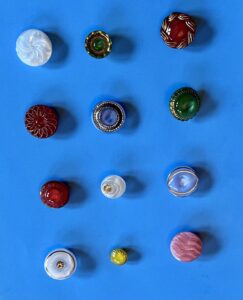
I was so inspired after attending the workshop to think outside the box and create art with buttons.
Here’s an example of how I used my creativity to express myself as a confetti dreamer. Maybe this will inspire you to create something, too.
Canvas + Button Project
- I started with a beautiful piece of cloth left over from when I covered some patio chairs. It was the perfect size to wrap a canvas I had in my art supplies.
- I used spray adhesive to secure the fabric to the canvas, lining up the circles with the edges of the canvas.
- Then I used a staple gun to staple it to the wooden frame on the backside of the canvas.
- I used the pattern of the fabric as the artwork and embellished it with buttons. *
- I used a hot glue gun to secure the threads on the backside of the canvas.
In total, this project took around two hours. And now I have this colorful piece that is a wonderful reminder of this event I attended with my mom. Priceless.
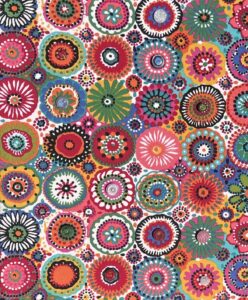
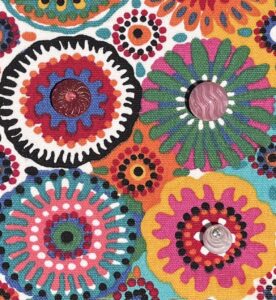
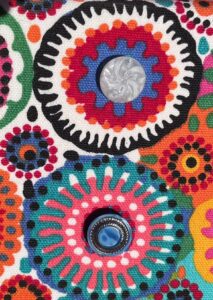
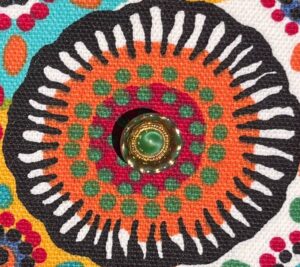
* This is my first experience attempting this, and I didn’t do any research, which means I learned some lessons. You must use a really small needle to get through a shank buttonhole compared to standard shirt buttons. My creative problem-problem-solving: I threaded the button first, tied a couple of knots, and then threaded the needle. Second problem: The thread was too thin for the hole made in the canvas by the needle, so I used a dab of hot glue to hold the thread in place. We’ll see if it lasts.
National Button Society (NBS) | Iowa State Button Society (ISBS) Facebook Group

